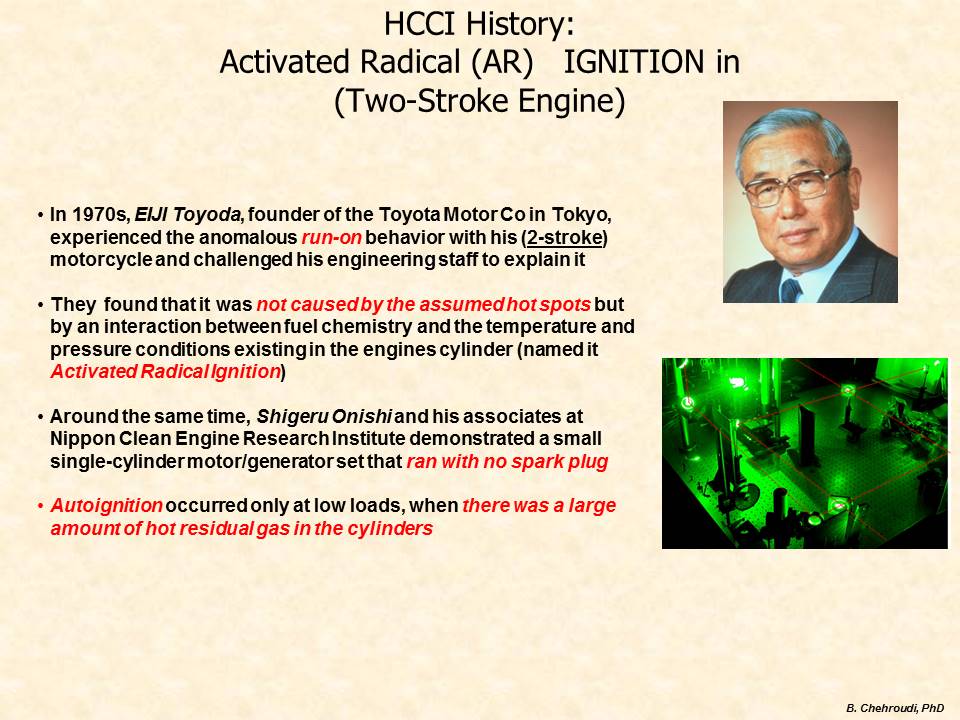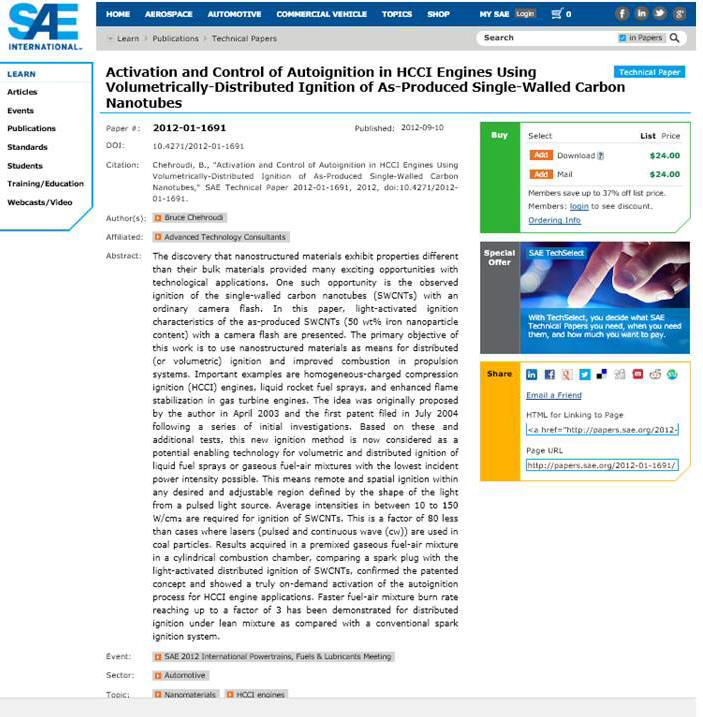HCCI engine is a hybrid of spark
ignition (SI) and compression ignition (IC) diesel engines
with a goal to theoretically harness advantages of both in a
single setting. Similar to SI engines, a homogeneous
fuel/air mixture is inducted into the engine. During the
compression stroke the temperature of the mixture increases
and reaches the point of autoignition; i.e. the combustion
is initiated without the help of any ignition system.
advantages of both in a
single setting. Similar to SI engines, a homogeneous
fuel/air mixture is inducted into the engine. During the
compression stroke the temperature of the mixture increases
and reaches the point of autoignition; i.e. the combustion
is initiated without the help of any ignition system.
The early studies of this
phenomenon were conducted on two-stroke engines with the
goal to reduce the hydrocarbon (HC) emission at part load
condition. The historical development in two-stroke engines
by itself is educational. In the l970s, Eiji Toyoda,
founder of Toyota Motor Co. In Tokyo, experienced the
abnormal run-on behavior with his motorcycles and challenged
his staff engineers to explain it. Masaaki Noguchi and a
team of researchers from Toyota and Nippon Soken Inc.
investigated this unusual effect, and determined that it was
caused not by the assumed hot spots but by an interaction
between fuel chemistry and the temperature and pressure
conditions in the engines’ cylinders. Specifically, the
self-ignited combustion tends “to occur at relatively low
cylinder pressures and temperature (compared to diesel
combustion), presumably by virtue of intermediate reaction
products [active radicals]”. Using partially-transparent
optical engines with quartz observation ports, the
researchers detected that the stable combustion behavior
was characterized by an intense blue glow, which was later
shown to be the fluorescence of active radicals. The group
named the phenomenon Toyota-Soken combustion.
Around the same time, Shigeru
Onishi and his coworkers at Nippon Clean Engine
Research Institute Co. Ltd. showed a small
single-cylinder motor/generator set (called the nice engine)
that ran with no spark. The team called the phenomenon they
observed active thermo-atmosphere combustion. In both these
research projects, the engineers could make their engines
operate sparkless on radical-initiated combustion, but
only at constant speed and load. They had, however,
determined some empirical characteristics of this third type
of burning. The autoignition occurred only at low loads,
when there was a large amount of hot residual gas in the
cylinders. As the temperature rose further during the
compression, the initiating reactions in the fresh chargewere beginning, and the hydrocarbons in the fuel were
breaking down into simpler compounds and activated
radicals.
Similar effects can be achieved
in four stroke engines as well. Like an SI engine the
charge is well mixed which minimizes particulate emissions,
and like a diesel engine it has no throttling losses, which
is beneficial for the part load operation. In addition, the HCCI engine can operate at diesel like compression ratios,
leading to comparable efficiencies. The distinction is that,
unlike either SI or CI engine the combustion occurs
simultaneously throughout the cylinder volume rather than
within a flame front. Hence, pressure ris e is very rapid
particularly when an stoichiometric or rich mixture is
used, for example, under high load conditions. See Fig. 1
for examples of SI and HCCI pressure traces. Many
investigators observed knock-like pressure oscillations in
HCCI engines under high load conditions. However, one
feature of the HCCI engine is that auto-ignition can be
achieved with very lean overall mixtures (much leaner than
can be ignited by spark ignition). This by itself, almost
eliminates the requirement of throttling at low engine
loads. It worth indicating that one main reason in
throttling spark ignited engine is to ensure spark ignitable
mixture. It should be obvious that there is no explicit
timing for the HCCI combustion. This is considered as one of
the unresolved and actively researched areas to best
control HCCI combustion in each cylinder.
e is very rapid
particularly when an stoichiometric or rich mixture is
used, for example, under high load conditions. See Fig. 1
for examples of SI and HCCI pressure traces. Many
investigators observed knock-like pressure oscillations in
HCCI engines under high load conditions. However, one
feature of the HCCI engine is that auto-ignition can be
achieved with very lean overall mixtures (much leaner than
can be ignited by spark ignition). This by itself, almost
eliminates the requirement of throttling at low engine
loads. It worth indicating that one main reason in
throttling spark ignited engine is to ensure spark ignitable
mixture. It should be obvious that there is no explicit
timing for the HCCI combustion. This is considered as one of
the unresolved and actively researched areas to best
control HCCI combustion in each cylinder.
It was shown that H, OH, and HO2
radicals play key role in autoignition process. In
general, the concentration of the hydrogen peroxide (H2O2)
increases in time and then begins to decompose (at
temperatures between 1050 to 1100 K) at high rate to
hydroxyl (OH) radicals. This reaction produces a large
number of OH radicals, most of which then react with fuel
molecules to generate water and heat. The increased
temperature brings the system into a very effective chain
branching state. The fundamental chemistry of HCCI
autoignition appears to be identical to that of knock in SI
engines. However, the picture does not favor the notion
that “active radicals” in the residual burned gases
survive both the exhaust and intake processes to play a role
in HCCI autoignition process in the next cycle.
Current research activities cover
areas such as control, startability, emissions of
hydrocarbon and carbon monoxide, power density, and
transition to other modes of operation, that is SI or
diesel. For more information refer to SAE 2001-01-2511 and
other SAE literature.

NOTE:
Course materials are in
preparation (contact us for more details). Consulting
activities are available.
